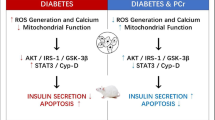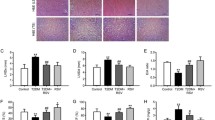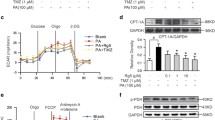Abstract
Purpose
To determine the mediation of spermine on energy metabolism disorder and diabetic cardiomyopathy (DCM) development as well as the underlying mechanisms.
Methods
An in vitro model of DCM was established by incubating primary cultured neonatal rat cardiomyocytes with high glucose (HG). Spermine content was assessed by RP-HPLC. The protein levels were detected by western blot. Mitochondrial functions were analyzed using the respiratory chain complex assay kit and immunofluorescence staining.
Results
The endogenous content of spermine was decreased in the HG group, and the protein levels of ornithine decarboxylase, respiratory chain complex (I–V), mitochondrial fusion-related protein (Mfn1, Mfn2), Cx43, N-cadherin, CaSR, and β-catenin (in cytomembrane) were also down-regulated by HG. In contrast, the protein levels of spermine-N1-acetyltransferase, gp78, Fis1, Drp1, and β-catenin were up-regulated by HG. Meanwhile, we observed that HG increased ubiquitination levels of Mfn1, Mfn2, and Cx43, decreased membrane potential (ΔΨm), and the opening of mitochondrial permeability transport pore (mPTP) followed by intracellular ATP leakage. The supplement of spermine or siRNA-mediated knockdown of gp78 significantly alleviated the detrimental effects of HG, while downregulation of CaSR aggravated the development of DCM. We further confirmed that the lower level of spermine by HG activates the gp78-ubiquitin-proteasome pathway via downregulation of CaSR protein level, which in turn damages mitochondrial gap junction intercellular communication and leads to reduced ATP level.
Conclusion
The protective role of spermine on energy metabolism disorder is based on higher CaSR protein level and lower gp78 activation, pointing to the possibility that spermine can be a target for the prevention and treatment of DCM.








Similar content being viewed by others
Availability of Data and Materials
The used and/or analyzed datasets are available from the corresponding author on reasonable request.
Abbreviations
- AMFR:
-
autocrine motility factor receptor
- ATP:
-
adenosine triphosphate
- ATP5F1:
-
ATP synthase F(0) complex subunit B1
- COX5A:
-
cytochrome c oxidase subunit Va
- Cx43:
-
connexin-43
- DCM:
-
diabetic cardiomyopathy
- Drp1:
-
dynamin-related protein 1
- ERAD:
-
endoplasmic reticulum related degradation
- Fis1:
-
fission 1
- GJIC:
-
gap junction intercellular communication
- GSK-3β:
-
glycogen synthase kinase 3 beta
- HG:
-
high glucose
- Hsp70:
-
heat-shock protein 70
- Mfn:
-
mitofusin
- ND1:
-
NADH dehydrogenase subunit 1
- ODC:
-
ornithine decarboxylase
- p-β-catenin:
-
phospho-β-catenin
- p-Cx43:
-
phospho-connexin-43
- p-GSK-3β:
-
phospho-glycogen synthase kinase 3 beta
- SDHA:
-
succinate dehydrogenase complex flavoprotein subunit A
- SLDT:
-
scrape-loading dye transfer technique
- SSAT:
-
spermine-N1-acetyltransferase
- TBST:
-
tris-buffered saline-Tween 20
- UQCRQ:
-
ubiquinol-cytochrome c reductase
- VDAC:
-
voltage-dependent anion channel
References
Rubler S, Dlugash J, Yuceoglu YZ, Kumral T, Branwood AW, Grishman A. New type of cardiomyopathy associated with diabetic glomerulosclerosis. Am J Cardiol. 1972;30(6):595–602.
Goyal BR, Mehta AA. Diabetic cardiomyopathy: pathophysiological mechanisms and cardiac dysfuntion. Hum Exp Toxicol. 2013;32(6):571–90.
Parim B, Sathibabu Uddandrao VV, Saravanan G. Diabetic cardiomyopathy: molecular mechanisms, detrimental effects of conventional treatment, and beneficial effects of natural therapy. Heart Fail Rev. 2019;24(2):279–99.
Kohli S, Chhabra A, Jaiswal A, Rustagi Y, Sharma M, Rani V. Curcumin suppresses gelatinase B mediated norepinephrine induced stress in H9c2 cardiomyocytes. PLoS One. 2013;8(10):e76519.
Bjornstad P, Schafer M, Truong U, Cree-Green M, Pyle L, Baumgartner A, et al. Metformin improves insulin sensitivity and vascular health in youth with type 1 diabetes mellitus. Circulation. 2018;138(25):2895–907.
Dickert N, Sugarman J. Ethical goals of community consultation in research. Am J Public Health. 2005;95(7):1123–7.
Raev DC. Which left ventricular function is impaired earlier in the evolution of diabetic cardiomyopathy? An echocardiographic study of young type I diabetic patients. Diabetes Care. 1994;17(7):633–9.
Wang Y, Gao P, Wei C, Li H, Zhang L, Zhao Y, et al. Calcium sensing receptor protects high glucose-induced energy metabolism disorder via blocking gp78-ubiquitin proteasome pathway. Cell Death Dis. 2017;8(5):e2799.
Marin-Garcia J, Akhmedov AT. Mitochondrial dynamics and cell death in heart failure. Heart Fail Rev. 2016;21(2):123–36.
Hom J, Sheu SS. Morphological dynamics of mitochondria--a special emphasis on cardiac muscle cells. J Mol Cell Cardiol. 2009;46(6):811–20.
Mahoney VM, Mezzano V, Mirams GR, Maass K, Li Z, Cerrone M, et al. Connexin43 contributes to electrotonic conduction across scar tissue in the intact heart. Sci Rep. 2016;6:26744.
Lock JT, Parker I, Smith IF. Communication of ca(2+) signals via tunneling membrane nanotubes is mediated by transmission of inositol trisphosphate through gap junctions. Cell Calcium. 2016;60(4):266–72.
Michela P, Velia V, Aldo P, Ada P. Role of connexin 43 in cardiovascular diseases. Eur J Pharmacol. 2015;768:71–6.
Harris TJ, Tepass U. Adherens junctions: from molecules to morphogenesis. Nat Rev Mol Cell Biol. 2010;11(7):502–14.
Harrison OJ, Bahna F, Katsamba PS, Jin X, Brasch J, Vendome J, et al. Two-step adhesive binding by classical cadherins. Nat Struct Mol Biol. 2010;17(3):348–57.
Orellana JA, Froger N, Ezan P, Jiang JX, Bennett MV, Naus CC, et al. ATP and glutamate released via astroglial connexin 43 hemichannels mediate neuronal death through activation of pannexin 1 hemichannels. J Neurochem. 2011;118(5):826–40.
Bai SZ, Sun J, Wu H, Zhang N, Li HX, Li GW, et al. Decrease in calcium-sensing receptor in the progress of diabetic cardiomyopathy. Diabetes Res Clin Pract. 2012;95(3):378–85.
He Y, Yang J, Li H, Shao H, Wei C, Wang Y, et al. Exogenous spermine ameliorates high glucose-induced cardiomyocytic apoptosis via decreasing reactive oxygen species accumulation through inhibiting p38/JNK and JAK2 pathways. Int J Clin Exp Pathol. 2015;8(12):15537–49.
Wei C, Wang Y, Li M, Li H, Lu X, Shao H, et al. Spermine inhibits endoplasmic reticulum stress-induced apoptosis: a new strategy to prevent cardiomyocyte apoptosis. Cell Physiol Biochem. 2016a;38(2):531–44.
Fu M, Zhang W, Wu L, Yang G, Li H, Wang R. Hydrogen sulfide (H2S) metabolism in mitochondria and its regulatory role in energy production. Proc Natl Acad Sci U S A. 2012;109(8):2943–8.
Connell JP, Augustini E, Moise KJ Jr, Johnson A, Jacot JG. Formation of functional gap junctions in amniotic fluid-derived stem cells induced by transmembrane co-culture with neonatal rat cardiomyocytes. J Cell Mol Med. 2013;17(6):774–81.
Sazanov LA. A giant molecular proton pump: structure and mechanism of respiratory complex I. Nat Rev Mol Cell Biol. 2015;16(6):375–88.
Meunier B, Fisher N, Ransac S, Mazat JP, Brasseur G. Respiratory complex III dysfunction in humans and the use of yeast as a model organism to study mitochondrial myopathy and associated diseases. Biochim Biophys Acta. 2013;1827(11–12):1346–61.
Loiola EC, Ventura AL. Release of ATP from avian Muller glia cells in culture. Neurochem Int. 2011;58(3):414–22.
Nazmara Z, Salehnia M, HosseinKhani S. Mitochondrial Distribution and ATP content of vitrified, in vitro matured mouse oocytes, Avicenna. J Med Biotechnol. 2014;6(4):210–7.
He Y, Xi J, Zheng H, Zhang Y, Jin Y, Xu Z. Astragaloside IV inhibits oxidative stress-induced mitochondrial permeability transition pore opening by inactivating GSK-3beta via nitric oxide in H9c2 cardiac cells. Oxidative Med Cell Longev. 2012;2012:935738.
Gupte SS, Chazotte B, Leesnitzer MA, Hackenbrock CR. Two-dimensional diffusion of F1F0-ATP synthase and ADP/ATP translocator. Testing a hypothesis for ATP synthesis in the mitochondrial inner membrane. Biochim Biophys Acta. 1991;1069(2):131–8.
Chai N, Zhang H, Li L, Yu X, Liu Y, Lin Y, et al. Spermidine prevents heart injury in neonatal rats exposed to intrauterine hypoxia by inhibiting oxidative stress and mitochondrial fragmentation. Oxidative Med Cell Longev. 2019;2019:5406468.
Wei C, Li H, Wang Y, Peng X, Shao H, Li H, et al. Exogenous spermine inhibits hypoxia/ischemia-induced myocardial apoptosis via regulation of mitochondrial permeability transition pore and associated pathways. Exp Biol Med (Maywood). 2016b;241(14):1505–15.
Lin Y, Zhang X, Wang L, Zhao Y, Li H, Xiao W, et al. Polyamine depletion attenuates isoproterenol-induced hypertrophy and endoplasmic reticulum stress in cardiomyocytes. Cell Physiol Biochem. 2014;34(5):1455–65.
Han L, Xu C, Jiang C, Li H, Zhang W, Zhao Y, et al. Effects of polyamines on apoptosis induced by simulated ischemia/reperfusion injury in cultured neonatal rat cardiomyocytes. Cell Biol Int. 2007;31(11):1345–52.
Hu J, Lu X, Zhang X, Shao X, Wang Y, Chen J, et al. Exogenous Spermine attenuates myocardial fibrosis in diabetic cardiomyopathy by inhibiting endoplasmic reticulum stress and the canonical Wnt signaling pathway. Cell Biol Int. 2020. https://doi.org/10.1002/cbin.11360
Wang Y, Chen J, Li S, Zhang X, Guo Z, Hu J, et al. Exogenous spermine attenuates rat diabetic cardiomyopathy via suppressing ROS-p53 mediated downregulation of calcium-sensitive receptor. Redox Biol. 2020;32:101514.
Mukherjee R, Chakrabarti O. Ubiquitin-mediated regulation of the E3 ligase GP78 by MGRN1 in trans affects mitochondrial homeostasis. J Cell Sci. 2016;129(4):757–73.
Wang N, De Bock M, Decrock E, Bol M, Gadicherla A, Vinken M, et al. Paracrine signaling through plasma membrane hemichannels. Biochim Biophys Acta. 2013;1828(1):35–50.
Hertig CM, Butz S, Koch S, Eppenberger-Eberhardt M, Kemler R, Eppenberger HM. N-cadherin in adult rat cardiomyocytes in culture. II. Spatio-temporal appearance of proteins involved in cell-cell contact and communication. Formation of two distinct N-cadherin/catenin complexes. J Cell Sci. 1996;109(Pt 1):11–20.
Zou J, Yue XY, Zheng SC, Zhang G, Chang H, Liao YC, et al. Cholesterol modulates function of connexin 43 gap junction channel via PKC pathway in H9c2 cells. Biochim Biophys Acta. 2014;1838(8):2019–25.
Bosada FM, Devasthali V, Jones KA, Stankunas K. Wnt/beta-catenin signaling enables developmental transitions during valvulogenesis. Development. 2016;143(6):1041–54.
Lee SH, Kim B, Oh MJ, Yoon J, Kim HY, Lee KJ, et al. Persicaria hydropiper (L.) spach and its flavonoid components, isoquercitrin and isorhamnetin, activate the Wnt/beta-catenin pathway and inhibit adipocyte differentiation of 3T3-L1 cells. Phytother Res. 2011;25(11):1629–35.
Ray K. Calcium-sensing receptor: trafficking, endocytosis, recycling, and importance of interacting proteins. Prog Mol Biol Transl Sci. 2015;132:127–50.
Pidasheva S, Grant M, Canaff L, Ercan O, Kumar U, Hendy GN. Calcium-sensing receptor dimerizes in the endoplasmic reticulum: biochemical and biophysical characterization of CASR mutants retained intracellularly. Hum Mol Genet. 2006;15(14):2200–9.
Wang R, Xu C, Zhao W, Zhang J, Cao K, Yang B, et al. Calcium and polyamine regulated calcium-sensing receptors in cardiac tissues. Eur J Biochem. 2003;270(12):2680–8.
Sun YH, Liu MN, Li H, Shi S, Zhao YJ, Wang R, et al. Calcium-sensing receptor induces rat neonatal ventricular cardiomyocyte apoptosis. Biochem Biophys Res Commun. 2006;350(4):942–8.
Sun J, Wei T, Bai S, Zhao H, Liu X, Yu J, et al. Calcium-sensing receptor-mediated mitogen-activated protein kinase pathway improves the status of transplanted mouse embryonic stem cells in rats with acute myocardial infarction. Mol Cell Biochem. 2017;431(1–2):151–60.
Funding
This research was supported by the National Natural Science Foundation of China (No. 81800260), University Nursing Program for Young Scholars with Creative Talents in Heilongjiang Province (UNPYSCT), Harbin Medical University Innovation and Entrepreneurship Training Project for College Students (No.201910226010 and No. 201910226448) and Heilongjiang Postdoctoral Fund (No. LBH-Z17103).
Author information
Authors and Affiliations
Contributions
CW, YHW and YWW designed the research and drafted the manuscript; YHW, YWW, FDL, XXL, and XYZ completed the experiment and data analysis; HZL, GDY, and CQX revised the paper and gave some suggestions. All authors reviewed the results and approved the final version of the manuscript.
Corresponding author
Ethics declarations
Conflict of Interests
The authors declare no potential conflicts of interest with respect to the research, authorship, and/or publication of this article.
Additional information
Publisher’s Note
Springer Nature remains neutral with regard to jurisdictional claims in published maps and institutional affiliations.
Rights and permissions
About this article
Cite this article
Wang, Y., Wang, Y., Li, F. et al. Spermine Protects Cardiomyocytes from High Glucose-Induced Energy Disturbance by Targeting the CaSR-gp78-Ubiquitin Proteasome System. Cardiovasc Drugs Ther 35, 73–85 (2021). https://doi.org/10.1007/s10557-020-07064-z
Accepted:
Published:
Issue Date:
DOI: https://doi.org/10.1007/s10557-020-07064-z




